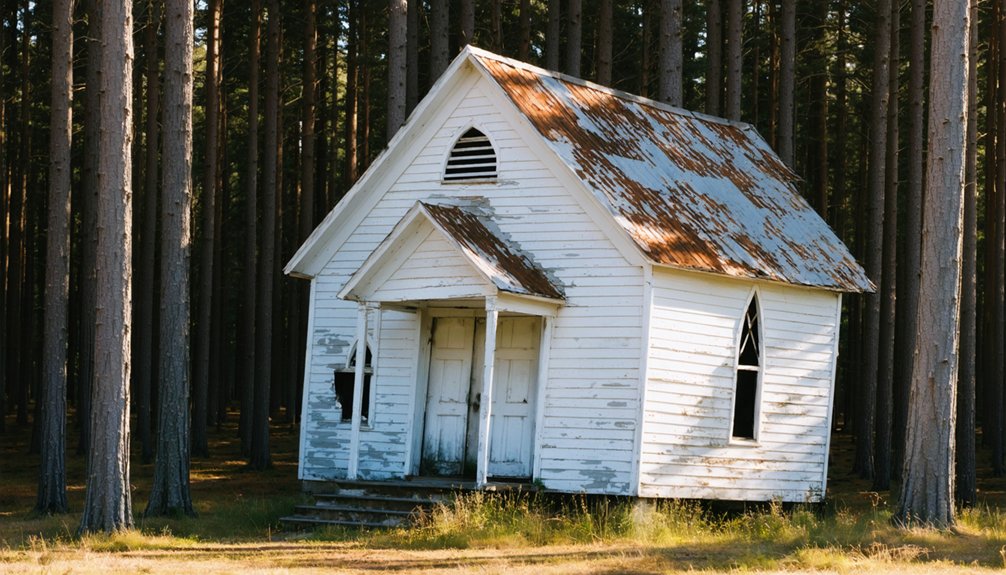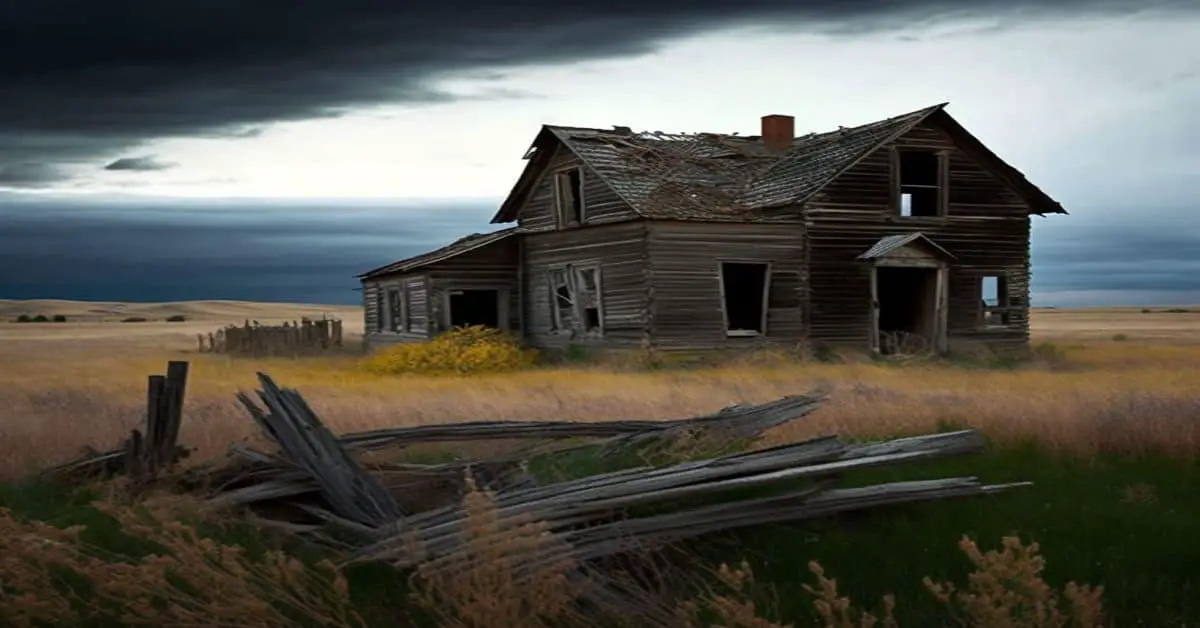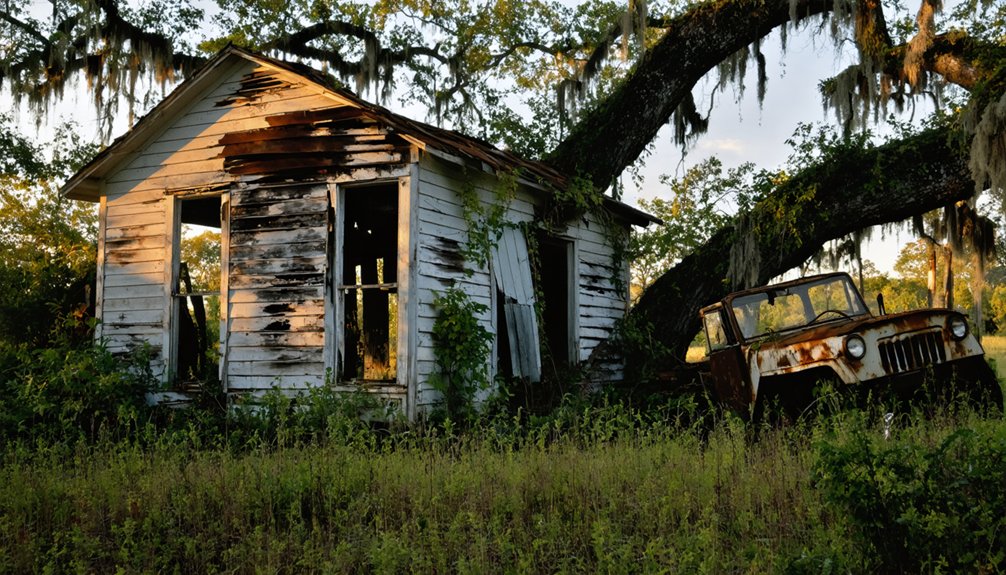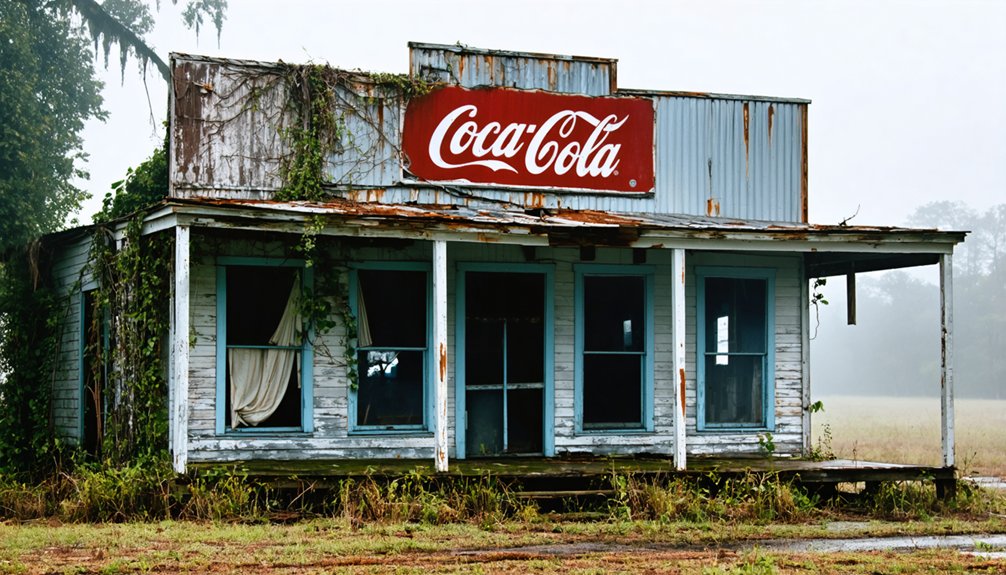You’ll find Peason’s ghost town ruins in Sabine Parish, Louisiana, where one of the largest sawmill operations west of the Mississippi River once transformed 40,000 acres of virgin pine forest into a thriving company town. From 1916 to 1935, this modern community of 2,000 residents enjoyed electricity, running water, and telephone service while producing four million board feet of lumber monthly. Beyond today’s remaining foundations, cemetery, and railway remnants lies a remarkable story of Louisiana’s lumber boom era.
Key Takeaways
- Peason was a thriving Louisiana lumber town established in 1916 that became a ghost town after its sawmill closed in 1935.
- The town supported 2,000 residents with modern amenities and produced 4 million board feet of lumber monthly at its peak.
- The mill’s closure led to a mass exodus of 450 skilled workers, leaving behind abandoned homes and infrastructure.
- Today, only foundations, an old cemetery, and railway remnants remain as evidence of the once-prosperous lumber community.
- The ghost town’s physical traces provide insight into early 20th-century lumber operations and Louisiana’s timber industry history.
The Birth of a Lumber Empire
In 1916, lumber magnates Anderson J. “Jasper” Peavy and Riley J. Wilson set their sights on 40,000 acres of virgin pine forest in Sabine Parish, Louisiana.
You’ll find their legacy in the town they created – Peason – cleverly named by combining their surnames. Their venture would transform the region’s lumber techniques, establishing what would become the largest pine mill west of the Mississippi.
The partners didn’t waste time. By 1918, they’d completed construction of their state-of-the-art mill, laying the foundation for a thriving community culture that would support up to 2,000 residents. The town boasted an impressive 134-room hotel among its many amenities. The company provided workers with modern conveniences like electricity, running water, and telephone service.
Within two years, Peavy and Wilson built more than a mill – they created a community that would become home to thousands.
With Peavy’s extensive experience in Texas lumber operations and the region’s newfound railroad accessibility, they created an operation that could process an impressive 4 million board feet of lumber monthly, setting new standards for industrial-scale logging in the American South.
Life in a Company Town
If you’d lived in Peason during its heyday, you’d have found your daily life centered entirely around the sawmill’s schedule, with work whistles marking the rhythms of your day.
You’d have enjoyed modern amenities rare for rural Louisiana at that time – running water, electricity, and indoor plumbing – all provided and maintained by the Peavy Wilson Lumber Company.
The mill generated an impressive four million board feet of lumber each month during peak production times.
While the company controlled nearly every aspect of residents’ lives, from housing assignments to shopping options at the commissary, they balanced this authority by providing a self-contained community complete with schools, churches, and entertainment.
Daily Rhythms and Routines
Life in Peason revolved around the rhythmic hum of the sawmill, where workers adhered to demanding schedules that often stretched from dawn to dusk. You’d start your day early, joining the stream of laborers heading to their assigned posts – whether at the mill, railroad, or logging sites.
Daily routines centered on maximizing timber production, especially during dry seasons when conditions were ideal. The mill’s impressive output of 4 million board feet monthly kept workers consistently busy.
After your shift, you’d return to your company-provided house, arranged in neat rows alongside your neighbors. Your evenings might include a visit to the movie theater, the bustling commissary, or church activities.
Children’s schedules aligned with Peason High School’s hours, while the railroad’s regular arrivals and departures punctuated the day’s rhythm. The town doctor, conveniently located in the company store, stood ready when health needs arose.
Company Control and Benefits
While many American towns grew organically, Peason existed entirely under the control of the Peavy Wilson Lumber Company, which owned all 40,000 acres and every structure within its boundaries.
The company’s influence extended into every aspect of daily life, from housing arrangements to essential services. You’d find yourself living in one of ten rows of company-built houses, shopping at the company store, and receiving medical care from the company doctor.
In exchange for accepting this limited resident autonomy, you’d enjoy amenities that were rare for rural Louisiana at the time: running water, electricity, a theater, and a well-equipped school.
The company provided these modern conveniences while maintaining a tight grip on the community through its thorough provision of services and employment.
Peak Years and Prosperity
During the prosperous years between 1917 and 1935, Peason flourished as a bustling company town of 2,000 residents, standing as a proof of successful lumber industry operations in Sabine Parish, Louisiana.
Peason exemplified early 20th-century industrial success, transforming Louisiana timberland into a thriving company town of 2,000 souls.
You’d have found a thriving community identity built around modern amenities uncommon in typical sawmill towns, including running water, electricity, and a 134-room hotel.
- The Christie and Eastern Railroad connected Peason to major markets, shipping lumber and transporting passengers.
- A company commissary served both town residents and surrounding areas.
- The town boasted a theater, garage, icehouse, and drug store.
- Peason High School graduated its first class in 1922, marking educational progress.
The town’s extensive infrastructure and services made it a model of company town planning, supporting both business operations and residential life. The area would later become part of a Wildlife Management Area where visitors can still explore remnants of the past.
The Railroad’s Role in Peason’s Success
As the backbone of Peason’s industrial success, the Christie & Eastern Railroad transformed this Louisiana lumber town into a thriving economic hub after its 1917 incorporation.
You’d find the standard gauge railroad stretching 10.6 miles from Sandel to Peason, connecting directly to the Kansas City Southern line and later extending to Kurthwood’s Red River and Gulf Line.
The railroad’s impact on logging efficiency was remarkable. Shay engines hauled logs from forest spurs to the main line, while Rod engines delivered them to the mill. The mill’s success was evident as it produced 4 million board feet between 1918 and 1929.
You’ll appreciate how this railroad connectivity enabled the mill to achieve staggering production numbers – up to 7 million board feet monthly during peak operations.
The line even offered unique passenger services, including the “Toonerville Trolley,” supporting workers’ daily commutes and the town’s vibrant community life.
From Boom to Bust: The Mill’s Final Days
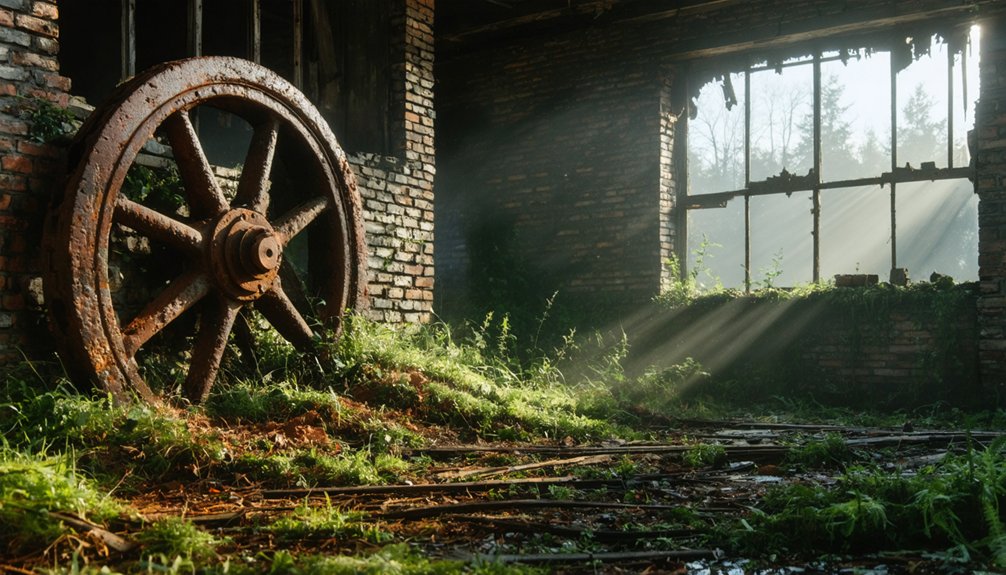
During Peason Mill’s final years from the late 1920s through 1935, you’d have witnessed the gradual exodus of workers as the once-mighty operation scaled back production from its peak of 7 million board feet per month.
While the company managed to avoid layoffs during the Great Depression by adjusting work hours, the combined pressures of depleted timber resources and economic downturn ultimately forced the mill’s closure and relocation to Holopaw, Florida.
You’d find that this shift devastated the local economy, as the departure of 200-450 mill workers and their families transformed the bustling company town of 1,500-2,000 residents into a ghost town almost overnight.
Economic Impact Assessment
When Peasy Wilson Lumber Company reached its zenith between 1918 and 1929, the mill’s economic impact transformed Peason into Louisiana’s premier lumber town west of the Mississippi.
You would’ve witnessed remarkable economic resilience as the mill churned out up to 7 million board feet monthly during peak production, generating substantial wealth for the region.
- Monthly revenues hit $125,000 with $80,000 in operating costs, creating stable profits
- Rail infrastructure connected Peason to national markets, employing a diverse workforce
- The mill maintained full employment through the Great Depression, a proof of sound management
- Total production reached 600 million board feet, with $18 million in gross revenue
Workforce Mass Exodus
The sudden closure of Peavy Wilson Lumber Company in 1935 triggered one of Louisiana’s most dramatic workforce dispersals, scattering 450 skilled laborers from Peason’s once-thriving community.
This mass exodus marked a defining moment in regional labor history, as both white and Black workers sought employment at distant mills, some traveling as far as Holipaw, Florida. Workers who had paid just $3.00 monthly rent in company housing were forced to abandon their homes. Like the timber workers before them in the early 1900s, these families faced severe hardships in company-controlled towns.
You’ll find no evidence of labor disputes or strikes causing this departure – instead, resource depletion and economic factors drove the workforce migration.
The mill’s closure left behind a ghost town, with abandoned houses and scattered unmarked graves of Black workers across Peason Ridge.
Within two years, even the post office shut down, erasing the final remnant of Peason’s industrial era and dispersing generations of skilled lumber workers across the South.
What Remains: A Ghost Town’s Legacy
Modern visitors to Peason, Louisiana will find scattered remnants of what was once a thriving lumber town of 2,000 residents. The ghost town’s cultural heritage lives on through its foundations, abandoned cemetery, and traces of the Christie and Eastern Railroad that once connected this industrial hub to major transportation lines.
While the ecological impact of clear-cutting transformed the virgin pine forests forever, today’s landscape tells the story of both exploitation and recovery.
- Foundations of the company-owned buildings including hotel, theater, and commissary
- Historic cemetery preserving the memory of early residents
- Remnants of the sawmill pond and railway beds
- Peason Ridge Wildlife Management Area, showcasing nature’s resilience
The 2022 EF2 tornado further reduced the physical structures, but you’ll still witness the echoes of Louisiana’s lumber era in what remains.
Natural Disasters and Modern Times
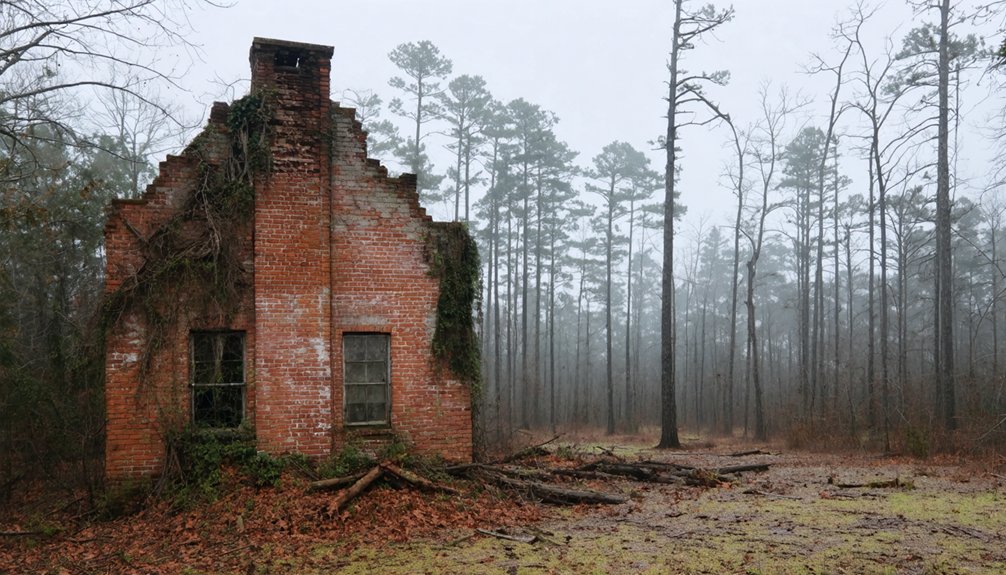
Natural forces continue shaping Peason’s remnants, most recently through a devastating EF2 tornado that struck in January 2022. The tornado’s aftermath left 30 homes damaged, with up to 15 severely impacted or destroyed. Six residents suffered injuries, including critical ones when a mobile home was lost.
You’ll find Peason’s story differs from other Louisiana ghost towns like Ruddock and Frenier, which hurricanes wiped out in 1915. While those communities fell to nature’s fury, Peason’s decline stems from economic forces – specifically, the 1935 closure of Peavy Wilson’s sawmill.
Today, the community’s resilience shows in its small remaining population and preserved structures that tell the tale of early 20th-century lumber operations, though modern amenities are sparse.
Frequently Asked Questions
What Happened to the Original Sawmill Equipment After the Mill Closed?
You’ll find no sawmill equipment preserved at the original site – it was all relocated by rail to Holopaw, Florida in 1935, where operations continued until 1947.
Were There Any Notable Crimes or Law Enforcement Issues in Peason?
You won’t find documented evidence of significant crime history or law enforcement issues in Peason’s records. The town’s remote location and company-managed structure likely contributed to minimal criminal activity.
Did Native American Tribes Have Any Significant Presence in the Area?
You’ll find significant tribal influence in the area, where Native Americans followed buffalo migrations through Peason Ridge and Anacoco Prairie, leaving behind a rich cultural heritage spanning thousands of years.
What Was the Average Wage for Workers at the Peason Sawmill?
While exact average salaries aren’t documented, you’d find workers earned around 35.9 cents per hour in 1930, typical for lumber industry worker conditions during that era in Louisiana.
Did Any Famous People or Historical Figures Ever Visit Peason?
You won’t find any records of famous visitors to Peason during its heyday. While the town had historical landmarks like its sawmill and school, it didn’t attract notable personalities or dignitaries.
References
- https://en.wikipedia.org/wiki/Peason
- https://www.sfasu.edu/heritagecenter/2439.asp
- https://thebayouinsider.substack.com/p/ghost-towns-and-forgotten-roads-louisianas
- https://www.sfasu.edu/heritagecenter/9916.asp
- https://louisianagenealogygirl.wordpress.com/2021/03/23/sawmill-towns/
- https://kids.kiddle.co/List_of_ghost_towns_in_Louisiana
- https://en.wikipedia.org/wiki/List_of_ghost_towns_in_Louisiana
- https://710keel.com/discover-70-ghost-towns-from-across-louisiana/
- https://www.sfasu.edu/heritagecenter/9709.asp
- https://www.crt.state.la.us/Assets/OCD/hp/nationalregister/historic_contexts/The_Louisiana_Lumber_Boom_c1880-1925.pdf
